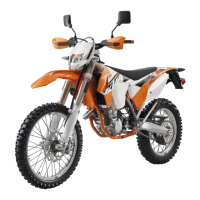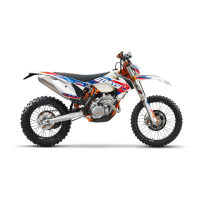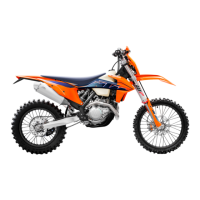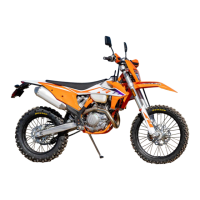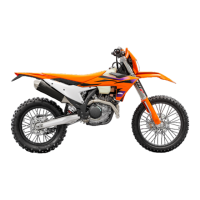Why are the lights not working on my KTM Motorcycle?
- MMolly Green DDSSep 7, 2025
If the high beam, low beam, parking light, tail light, and license plate lamp are not working on your KTM Motorcycle, check if fuse 3 is blown and replace it.

Why are the lights not working on my KTM Motorcycle?
If the high beam, low beam, parking light, tail light, and license plate lamp are not working on your KTM Motorcycle, check if fuse 3 is blown and replace it.
Why is the speedometer not working on my KTM 500 EXC AUS Motorcycle?
If the speedometer, horn, brake light, turn signal, and radiator fan are not working on your KTM Motorcycle, check if fuse 4 is blown and replace it.
Why is my KTM 500 EXC AUS battery discharged?
If the battery of your KTM Motorcycle is discharged, the alternator may not be charging it. Check the charging voltage and the stator winding of the alternator. Also, check for any undesired power consumers.
Why KTM 500 EXC AUS Motorcycle engine won't crank with electric starter?
If the electric starter on your KTM Motorcycle isn't cranking the engine, there could be a few reasons. You might be making an operating error, so double-check the start procedure. A discharged battery is a common cause, so try charging it. Also, a blown main fuse can prevent the starter from working, so replace it if needed. Finally, the starter relay or the starter motor itself could be defective, requiring a check of these components.
What does it mean when the FI warning lamp (MIL) lights up on my KTM 500 EXC AUS?
If the FI warning lamp (MIL) lights up or flashes on your KTM Motorcycle, it indicates a defect in the fuel injection system. Stop the motorcycle and identify the faulty part using the blink code. Check the cabling for damage and the electrical plug-in connections for corrosion and damage. You may also need to read out the fault memory using the KTM diagnostics tool.
| Bore x Stroke | 95 mm x 72 mm |
|---|---|
| Transmission | 6-speed |
| Seat Height | 960 mm |
| Starter | Electric starter |
| Ground Clearance | 355 mm |
| Cooling System | Liquid cooled |
| Rear Suspension | WP Xplor PDS shock absorber |
| Rear Brake | Disc brake |
| Engine Type | 1-cylinder, 4-stroke engine |
| Power | Not available |
| Torque | Not available |
| Fuel System | Electronic fuel injection (Keihin EMS) |
| Front Suspension | WP Xplor 48 upside-down fork |
| Frame | Central double-cradle type 25CrMo4 steel |
| ABS | No |
Explains the meaning of various symbols used throughout the owner's manual.
Details the typographical formats, such as specific names and brands, used in the manual.
Defines the specific intended use and limitations of the KTM sport motorcycle.
Outlines essential safety instructions for operating the vehicle safely.
Explains hazard symbols and risk levels to ensure user awareness.
Provides practical guidelines for operating the motorcycle safely.
Emphasizes the importance of wearing appropriate protective clothing while riding.
Details the terms and conditions related to the motorcycle's guarantee and warranty.
Lists and describes the recommended operating fluids and auxiliary substances.
Highlights the critical role of proper service for vehicle longevity and performance.
Illustrates the front left view of the motorcycle with numbered labels for key components.
Illustrates the rear right view of the motorcycle with numbered labels for key components.
Provides information on where to find the chassis number, engine number, and type label.
Details the locations for identifying fork and shock absorber part numbers.
Explains the operation and function of various controls located on the handlebars.
Describes the various indicator lamps on the dashboard and their functions.
Details the operation of the electric starter and idle speed adjustment screw.
Provides an overview of the speedometer display and its various modes.
Guides on how to set the clock, change units, and adjust speedometer functions.
Provides essential advice and safety precautions for the first ride.
Details the recommended procedure for running in the engine to ensure longevity.
Outlines specific preparations for riding in challenging environmental conditions.
Lists essential checks and maintenance tasks to perform before riding.
Guides on how to start the engine and begin riding the motorcycle.
Explains proper techniques for shifting gears, riding, and braking.
Details the recommended maintenance tasks based on operating hours or time intervals.
Lists optional service tasks that may be required in addition to the regular schedule.
Explains how to adjust suspension settings based on the rider's weight.
Details how to adjust the low-speed and high-speed compression damping.
Guides on adjusting fork compression, rebound damping, and spring preload.
Covers removal, installation, and maintenance of fork legs and triple clamps.
Procedures for checking, adjusting, and greasing the steering head bearing.
Instructions for removing, cleaning, and installing the air filter and its box.
Guides on cleaning, checking, and adjusting the drive chain tension.
Explains how to check and adjust the free travel of the hand brake lever.
Details how to check the wear limits of brake discs and linings.
Guides on checking and adding brake fluid for front and rear brakes.
Procedures for removing and installing the front and rear wheels.
Instructions for inspecting tire condition and verifying air pressure.
Covers battery removal, installation, and charging procedures.
Guides on changing the main fuse and individual component fuses.
Procedures for headlight mask, bulb replacement, and setting alignment.
Explains how to check the coolant and antifreeze levels for proper engine cooling.
Details the steps for draining and refilling the motorcycle's coolant.
Guides on checking and adjusting the play in the throttle cable.
Explains how to adjust the engine's idle speed and shift lever position.
Covers changing the fuel screen and checking the engine oil level.
Details the process for changing the engine oil and oil filter.
Provides instructions on how to properly clean the motorcycle.
Outlines necessary checks and maintenance steps for winter storage or use.
Steps to take when storing the motorcycle for an extended period.
Instructions for getting the motorcycle ready after it has been stored.
Diagnoses common issues related to engine starting and operation.
Addresses problems with engine power loss and overheating.
Lists and explains the diagnostic blink codes for the FI warning lamp.
Provides detailed engine specifications and tightening torque values.
Lists specifications for the chassis, frame, and electrical system components.
Details specifications for the front fork and rear shock absorber.
Specifies approved types of brake fluid and coolant for the motorcycle.
Lists recommended engine oil types and specifications for optimal performance.
Lists recommended products for cleaning air filters, chains, and general surfaces.
Recommends specific greases, lubricants, and sprays for various applications.
Explains the JASO T903 MA standard for motorcycle engine oils.
Describes the SAE system used for classifying oil viscosity.
